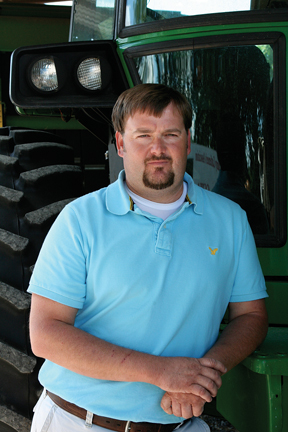OYFF: Allergic To His Work, Saucer Plows On With Love Of Farming

When the going gets rough, Scott Saucer has a friend who taunts him with the question: “And you do this for what reason?”But Scott knows why he keeps on farming — he enjoys it.”It’s something you’ve got to deal with, something you’ve got to live with,” Scott said of the inevitable setbacks. “And I wouldn’t do it if I didn’t enjoy it.He enjoys it even when hurricanes rip apart his crops, even when droughts turn profits into dust and even when doctors tell him he’s allergic to his work.That’s because the 31-year-old Saucer, who captured the Peanut Division of the Alabama Farmers Federation’s Outstanding Young Farm Family competition, has a long-running love affair with the soil.”Turned loose” on a tractor at age 9, young Scott decided early on that there would be no office jobs for him.”Farming’s always been my passion; it’s always been something I’ve enjoyed,” he said. “I’ve always enjoyed working. Long hours don’t bother me. I farm because I’m growing something — food for people, clothes for people — and I couldn’t see myself doing anything else. We do the same thing every year — plant, harvest, spray — there’s always something going on. In an office, you’ve got something to do, you do it and then you’re done. I can’t sit down and be done.”So it must’ve felt like a cruel trick last winter when, after an agonizing sinus surgery, the results of an allergy test showed Scott was allergic to his work.”I’m allergic to all types of grasses, all types of weeds, all types of molds in the soil, all the crops that I produce,” Scott said. “And the only way to cure that is to give myself two shots every five days for a year to two years. The shots are supposed to build my immune system…. But I’ve just learned to deal with it and keep going. I’m not going to change occupations because of it.”And so, Scott plows on — literally. This year, the 1,100-acre farm that was once primarily peanuts and cotton is also planted with 150 acres of irrigated corn and 150 acres of soybeans, which followed behind the wheat planted last winter.”We started getting into the grains because of grain prices going up and cotton prices and peanuts weren’t doing as well,” Scott said. “With the diseases we’ve had around and the drought, it’s just been hard to grow peanuts the past couple of years. But with irrigation, we found it was a little easier to grow grain, so we shifted into the grain market a little bit.”Of course, even diversification has its price.
“I thought if we could diversify, it would help get a lot of the crunch time out, but it has just stretched out my busy season,” he said. “I’m having to learn the new varieties of corn. We used to farm corn when we had hogs years ago, and I was familiar with it back then. But now I have to relearn the varieties and what does best for us as far as yields and irrigated yields.”Wheat is something I’ve never had experience on, and I have to learn a lot about wheat and soybeans mainly,” Scott continued. “But yes, the diversification is a lot of learning. I like it because it helps keep a steady income coming in. If one crop doesn’t do as well, another crop can make up for it.”Or, at least, that’s true in theory. In reality, however, grain prices are being outpaced by even higher fertilizer and fuel costs.”I had one friend who said he would have taken last year’s commodity prices if we could have kept last year’s prices for fertilizer and diesel,” Scott said. “And that’s probably true because fertilizer and diesel have put such a pinch on us. Our input costs have gotten so large that the banks are really cracking down, and financial institutions are having to realize that it takes a lot of us to put a crop in the ground and a lot to get a crop out of the ground. When you go into the bank asking for more money and they want to know why, you have to explain why.”They don’t realize that I might spend $1,000 a day just in diesel fuel during harvest season, running a peanut and cotton operation all at the same time. I figured it up, and it’s going to cost anywhere from $1,000 to $1,400 a day, depending on how many tractors I’ve got running that one day during harvest season,” he said.With such a precarious balance between income and outgo, Scott said he’s even more thankful that he’s got a wise and patient partner in his father, Wesley.”The biggest thing he’s taught me is patience and the values of farming and the values of life,” Scott said. “He always told me to put the Lord first, let the Lord handle everything and to trust in Him, and do the right thing because lies and deceit have never gotten anybody anywhere. It always comes back to haunt you.”One example of that, Scott said, is in booking commodities.”Dad always taught me to not get greedy when we’re booking grain,” he said. “He taught me to book a price and never look back. Never book more than we can handle or more than we can produce. If we booked, he said, ‘Book it, and be done. If the price goes up, that’s fine. If the price goes down, that’s fine.'”
